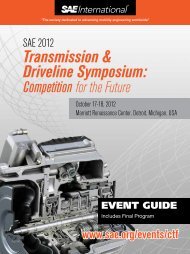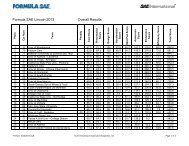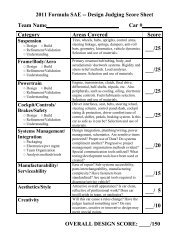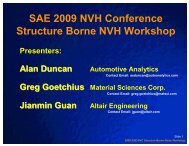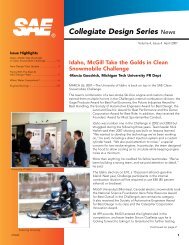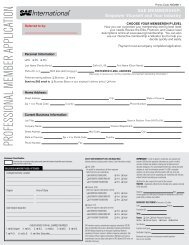The 4T50ME-GI Test Engine at MAN Diesel & Turbo's ... - Sae.org
The 4T50ME-GI Test Engine at MAN Diesel & Turbo's ... - Sae.org
The 4T50ME-GI Test Engine at MAN Diesel & Turbo's ... - Sae.org
You also want an ePaper? Increase the reach of your titles
YUMPU automatically turns print PDFs into web optimized ePapers that Google loves.
Fig. 14: Arrangement of double-wall piping in ventil<strong>at</strong>ion system<br />
glycol-w<strong>at</strong>er flow is constant and inde-<br />
pendent of the LNG flow r<strong>at</strong>e. <strong>The</strong> va-<br />
poriser-gas outlet temper<strong>at</strong>ure (45 °C)<br />
is controlled by the glycol-w<strong>at</strong>er tem-<br />
per<strong>at</strong>ure set-point.<br />
Gas-pressure control:<br />
<strong>The</strong> cryogenic pump is equipped with a<br />
discharge control valve. When the dis-<br />
charge control valve is open, gas flows<br />
to the vaporiser. If the gas pressure from<br />
the vaporiser outlet is higher than the<br />
gas pressure set-point from the GECU<br />
(ME-<strong>GI</strong> engine control system), the<br />
cryogenic-pump speed is decreased. If<br />
the cryogenic-pump speed reaches the<br />
minimum speed, a control valve opens<br />
to the venting mast.<br />
Gas train<br />
<strong>The</strong> gas is supplied from the vaporiser<br />
outlet through a single-wall, high-pres-<br />
sure pipe to the gas train, installed out-<br />
side the engine room, consisting of two<br />
block valves and one bleed valve (see<br />
Fig. 13).<br />
<strong>The</strong> volume between the block and<br />
bleed valves is depressurised while the<br />
gas system is out of oper<strong>at</strong>ion (block<br />
valves are closed and bleed valve<br />
open). This is a safety arrangement in<br />
<strong>MAN</strong> B&W <strong>Diesel</strong><br />
order to ensure th<strong>at</strong> no gas can unin-<br />
tentionally be supplied to the engine. A<br />
valve-leakage test is autom<strong>at</strong>ically con-<br />
ducted before gas oper<strong>at</strong>ion based on<br />
the pressure-drop over time.<br />
Double-wall gas pipes<br />
From the gas train, the gas enters the<br />
engine room and from here the gas is<br />
supplied courtesy of a double-wall pip-<br />
ing system. <strong>The</strong>se are, according to<br />
IMO guidelines, “gas-safe machinery<br />
spaces” where the engine room is main-<br />
tained as an ordinary engine room and<br />
not a hazardous area. <strong>The</strong> space be-<br />
tween the inner, high-pressure pipe and<br />
the outer pipe is continuously ventil<strong>at</strong>ed<br />
– approxim<strong>at</strong>ely 30 air changes per<br />
hour – by a mechanical ventil<strong>at</strong>or made<br />
of spark-free fan m<strong>at</strong>erial, installed out-<br />
side the engine room. <strong>The</strong> double-wall<br />
inlet must be supplied from a gas-safe<br />
area. In the event of a gas leakage from<br />
pipe rupture or sealing failure, the leak-<br />
age is detected with a HC sensor in-<br />
stalled in the ventil<strong>at</strong>ion-pipe outlet. <strong>The</strong><br />
double-wall piping should be arranged<br />
as shown in Fig. 14.<br />
<strong>The</strong> double wall ventil<strong>at</strong>ion system<br />
is also part of the engine internal gas<br />
system and every valve, gas injection<br />
valves and high pressure sealings are<br />
connected to this system. <strong>The</strong> high<br />
pressure outlet from the engine will have<br />
to be connected with a silencer of suf-<br />
ficient capacity – see Fig. 15.<br />
Fig. 15: <strong>The</strong> high-pressure engine outlet needs to be connected with a silencer of sufficient capacity<br />
<strong>The</strong> <strong>4T50ME</strong>-<strong>GI</strong> <strong>Test</strong> <strong>Engine</strong> <strong>at</strong> <strong>MAN</strong> <strong>Diesel</strong> & Turbo’s Copenhagen <strong>Test</strong> Centre<br />
16



